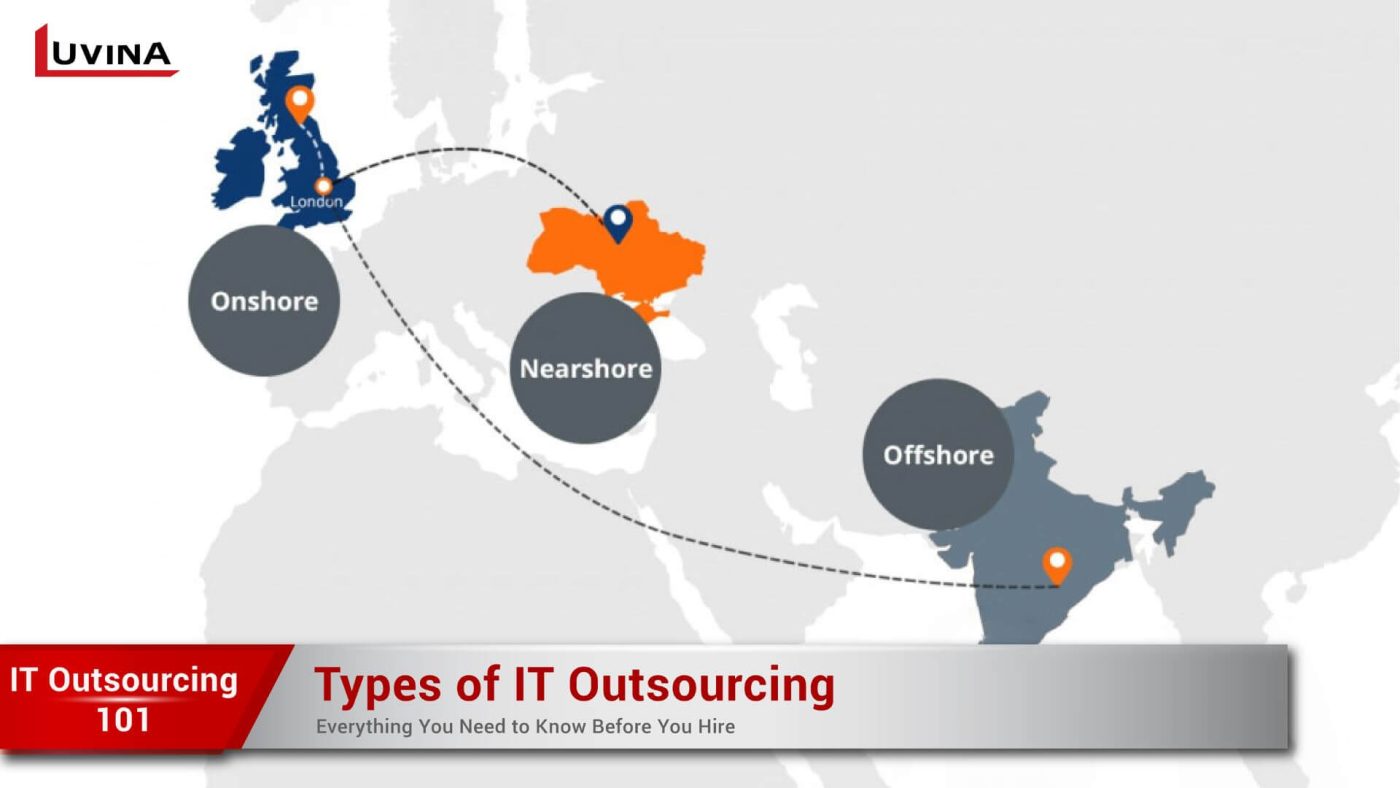In today’s fast-paced business landscape, IT outsourcing has become a crucial strategy for organizations looking to optimize operations, reduce costs, and access specialized expertise.
This comprehensive guide offers an in-depth roadmap for IT outsourcing, including steps, types, and valuable tips to ensure a successful transformative journey. Whether you’re a startup seeking efficient scaling or a well-established enterprise looking to streamline your processes, this guide equips you with the knowledge and insights needed to harness the full potential of IT outsourcing.
Understanding IT Outsourcing
Let’s start by exploring what IT outsourcing means, differentiating it from in-house development.
IT outsourcing refers to the practice of using outside service providers to manage some or all of IT tasks. These tasks may involve managing the service desk, developing software, managing the infrastructure, leading strategy, and more.
IT outsourcing provides significant benefits such as cost savings, access to skills, and scalability. However, it also comes with its challenges.
In this blog post, we’ll cover everything you need to know before hiring an IT outsourcing partner.
1. Benefits of IT outsourcing
Outsourcing IT services empowers businesses with cost savings, expert access, enhanced productivity, reduced security risks, and heightened competitiveness. Discover the key advantages here:

- Scalability: Adapt swiftly to market changes and varying demands. IT outsourcing offers flexibility, scalability, and top-notch quality across a range of projects and processes.
- Expertise: Tap into a global pool of skilled, seasoned, and innovative talent. Bridge local IT talent gaps effortlessly.
- Productivity: Focus on core objectives and boost efficiency. Entrust IT tasks to experts for quicker, superior results. Prevent business slowdowns due to IT issues or staff transitions.
- Security: Elevate data security and compliance through service providers’ specialized resources. Mitigate cyber risks, data breaches, and human errors with robust IT security measures. Enhance disaster recovery and backup solutions.
- Competitiveness: Gain an edge over rivals by leveraging the speed, cost-efficiency, and innovation inherent in IT outsourcing. Access cutting-edge technologies and solutions beyond in-house capabilities.
- Cost efficiency: Streamline expenses by paying only for essential services. Cut costs associated with in-house IT staff, equipment, and software. Tailor IT spending to match precise needs.
>> Also read: How to Optimize the IT Outsourcing Costs?
2. Challenges and risks of IT outsourcing
While IT outsourcing offers numerous benefits, it comes with its fair share of challenges and risks. Businesses need to be mindful of these potential downsides before engaging external service providers. Here are some common challenges:

- Loss of control: Outsourcing may result in reduced control over quality, timeliness, and security. Monitoring, managing, and maintaining communication with service providers becomes crucial. Legal and contractual issues may arise in case of service provider failures or breaches.
- Cultural differences: Collaborating with service providers from diverse countries and cultures can lead to language barriers, communication challenges, time zone differences, work style clashes, and differing expectations. These issues may lead to misunderstandings, conflicts, or project delays. Ethical and social disparities can also pose concerns.
- Hidden costs: Hidden or unforeseen costs may inflate the total cost of ownership. Expenses could include fees for contract negotiation, project management, quality assurance, change requests, maintenance, support, training, integration, or contract termination. Currency fluctuations and tax implications might further impact costs.
- Dependency: Outsourcing critical functions can create dependency on service providers. Transitioning or terminating agreements may prove challenging if a business desires to bring IT functions back in-house or switch to another provider, potentially leading to vendor lock-in risks.
- Security: Sharing sensitive data with service providers exposes businesses to security risks. Data breaches, theft, or misuse can occur if service providers lack adequate security measures or policies, potentially resulting in legal and reputational damage.
These challenges, while significant, are not insurmountable. Businesses should approach them with a proactive mindset, as overcoming obstacles is inherent to the entrepreneurial spirit.
>> See more: The Pros and Cons of IT Outsourcing to Compare with In-house IT Department
Initiating Your IT Outsourcing Journey
Step 1: Defining Your IT Outsourcing Requirements
When embarking on any endeavor, the first crucial step is to identify your goals and needs. The same principle applies when engaging in IT outsourcing services – your initial task is to pinpoint your requirements.
Common IT Outsourcing Needs: Frequently sought-after IT outsourcing services are web development, mobile app development, software testing, IT support, digital transformation, and more.
Step 2: Selecting the Ideal Types of IT Outsourcing
There are three primary IT outsourcing types: onshore, nearshore, and offshore. Each type possesses distinct characteristics and suits various business sectors within enterprises.

Onshore outsourcing involves hiring external companies, organizations, or freelancers to provide IT services within your own country – essentially domestic IT outsourcing.
Nearshore IT outsourcing entails engaging external entities, whether companies, groups, or freelancers, operating in a neighboring country or one with a similar time zone.
Offshore development center, on the other hand, entails contracting external companies, organizations, or freelancers in a different continent or a country with a disparate time zone – typically located far from the market that consumes the services.
Choosing the most suitable type of IT outsourcing depends on your needs and budget for your project.
Step 3: Discovering the Perfect IT Outsourcing Partner
Selecting the right IT outsourcing partner is a pivotal decision that can profoundly impact your business’s success or failure. To make this choice wisely, businesses must evaluate several factors and criteria when vetting potential partners, including:

- Reputation: Thoroughly investigate the service provider’s reputation and credibility. Scrutinize their work portfolio, client feedback, awards, certifications, and references. Additionally, assess their legal standing, financial stability, and compliance status.
- Expertise: Assess the service provider’s knowledge and experience by examining their skills, qualifications, tools, methodologies, and adherence to best practices. Analyze the quality and innovation of their previous work.
- Communication: Ensure that the service provider offers effective communication channels and methods, well-defined communication plans and reporting structures, and a dedicated contact or project manager.
- Cultural alignment: Verify whether the service provider aligns with your culture and values in terms of language, time zone, work style, and expectations. Assess their cultural diversity, adaptability, and sensitivity to different cultures and markets.
Managing the IT Outsourcing Process
Once you’ve found the right partner, the next crucial step is ensuring the project is completed on time and to high-quality standards. This requires a clear and seamless process of communication and collaboration. Here are some key tasks:
- Negotiating the Contract
Effectively document critical contract details, including scope, duration, models, quality standards, security protocols, and responsibilities. Formalizing these details in written form ensures that both parties are aware of their obligations.
- Efficient Project Management
Project management is no easy feat. To ensure a smooth project flow, you’ll need a dedicated project manager who serves as the bridge between you and your partner.

The project management process begins with selecting the right IT outsourcing model. From there, leverage its advantages to establish an exchange process that suits both your organization and your partner.
For instance, when it comes to project progress updates, do you prefer reports on paper or weekly meetings? Effective project management gets you one step closer to success.
If you lack experience in managing IT outsourcing projects, don’t hesitate to seek advice from experts like Luvina. With years of offshore experience and insights gained from over 1,000 successful projects, we’re ready to provide guidance tailored to your needs.
>> See more: How to Manage Your Outsourcing IT department Effectively
Conclusion
IT outsourcing offers numerous benefits like scalability, expertise, cost savings, productivity, security, and competitiveness. However, it also brings challenges and risks. Businesses must carefully evaluate the pros and cons before selecting a partner based on reputation, expertise, cost, communication, and culture.
Done right, IT outsourcing can drive business growth and innovation. If you seek a reliable IT partner offering top-quality solutions at affordable rates, contact us. We’re a leading IT outsourcing firm in Vietnam specializing in software development, data security, cloud computing, and technical support. Our skilled team delivers excellence and has a strong track record across industries and regions, ensuring solutions that match your needs.
To learn more about the IT Outsourcing, check out these additional resources:
- IT Outsourcing Operation: Trends and Prediction
- Top Countries for Startups to Outsource Software Development
Leave your information so we can send you this document directly to your email!









Read More From Us?
Sign up for our newsletter
Read More From Us?
Sign up for our newsletter